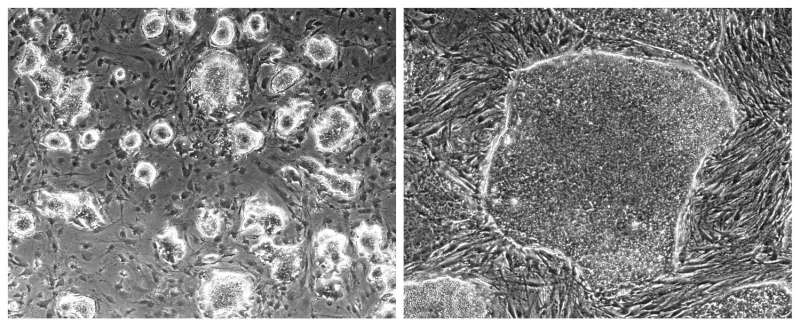Defining what it means to be a naive stem cell

Whitehead Institute scientists have created a checklist that defines the "naive" state of cultured human embryonic stem cells (ESCs). Such cells can mature into almost any cell type and more closely resemble the unique molecular features of pluripotent cells in the early human embryo than conventional ESCs in later stages of development. Although scientists have been very interested in working with naive stem cells, they have lacked a common definition of what makes a cell truly naive.
"In our opinion, most of the published protocols to generate so-called naive stem cells are not convincing because they produce cells that very much like the starting cells—there's not much difference in gene expression," says Whitehead Founding Member Rudolf Jaenisch, who is also a professor of biology at MIT. "The naive ESC state that we have defined is, based on gene expression, DNA methylation and X chromosome inactivation, very close to that of the human cleavage stage embryo."
For years, most ESC research focused on mouse cells because they are readily available and survive well in the lab, whereas human ESCs have been difficult to obtain and culture. However, mouse and human ESCs fundamentally differ in appearance and gene expression, and the numerous tools used to study mouse ESCs do not necessarily translate to human ESCs.
Recently, scientists in the lab of Whitehead Founding Member Rudolf Jaenisch developed a method to revert and maintain human ESCs in a naive state that closely resembles that of mouse ESCs. Now researchers from the Jaenisch lab, Didier Trono's lab at the Ecole Polytechnique Federale de Lausanne, and Joseph Ecker's lab at the Salk Institute for Biological Studies have assembled a checklist of characteristics human ESCs must have to be considered naive. Their work is described online in the journal Cell Stem Cell.
First, the team used technology developed by the Trono lab to look at the expression of transposable elements—also known as "jumping genes"—whose expression in ESCs is tightly regulated. Because the human genome contains about four million transposable elements—significantly more than its 25,000 genes—the team compared the transposable element profiles of naive human ESCs to cells from early stage human embryos. They identified significant overlap between the two cell states, whereas the profiles of conventional human ESCs are highly divergent.
With a transposable element profile in hand, the team examined the methylation of the ESCs' genomes. By adding and removing methyl groups to their DNA, cells can control gene expression. Scientists from the Ecker lab mapped the methylation of naive ESCs down to individual DNA bases and compared it to early ESCs. Like early stage human embryos, naive ESCs displayed a genome-wide reduction in methylation levels, which is not seen in conventional ESCs.
The team then investigated another method for controlling gene expression—X chromosome inactivation. Female human and mouse cells have two copies of the X chromosome, but during development, one copy is turned off to prevent overexpression of the X chromosome's genes. Usually, expression of the Xist gene is associated with one of the X chromosomes' inactivation, but surprisingly, both X chromosomes are active in naive ESCs and early human embryos, despite upregulation of Xist.
The final test to assess naive human ESCs' flexibility is implanting them into a mouse in order to form a chimera, which is considered the "gold standard" for demonstrating that mouse ESCs are pluripotent. The team found that naive human ESCs incorporate very inefficiently into mouse embryos. Therefore, the scientists say that this test is not a good criterion to define naive ESCs.
Thorold Theunissen, a postdoctoral fellow in the Jaenisch lab and co-first author of the Cell Stem Cell paper, sums up the team's findings this way: "If you compare naive human ESCs to their human embryo counterparts, there is a lot of convergence. If you compare them to mice, there are a lot of differences. But you really shouldn't be comparing them to mice. Otherwise you're just drawing the wrong conclusions."
This work was supported by the Simons Foundation (SFLIFE #286977), National Institutes of Health (NIH RO1-CA084198), Swiss National Science Foundation, European Research Council (KRABnKAP, No. 268721), Howard Hughes Medical Institute (HHMI), Gordon and Betty Moore Foundation (GBMF3034), Mary K. Chapman Foundation, a Sir Henry Wellcome Postdoctoral Fellowship (098889/Z/12/Z), a Foundation Bettencourt Award, the Association pour la Recherche sur le Cancer (ARC), and a grant from the Fonds de la Recherche en Sante du Quebec. Jaenisch is co-founder of Fate Therapeutics and an adviser to Stemgent.
More information: "Molecular Criteria for Defining the Naive Human Pluripotent State" Cell Stem Cell, online July 14, 2016. dx.doi.org/10.1016/j.stem.2016.06.011
Journal information: Cell Stem Cell
Provided by Whitehead Institute for Biomedical Research


















